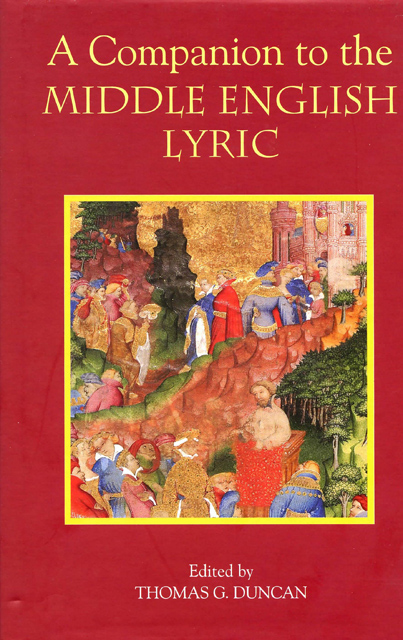Book contents
- Frontmatter
- Contents
- Acknowledgements
- Abbreviations
- Editorial Note
- Introduction
- 1 Middle English Lyrics and Manuscripts
- 2 Middle English Lyrics: Metre and Editorial Practice
- 3 The Love Lyric before Chaucer
- 4 Moral and Penitential Lyrics
- 5 Middle English Religious Lyrics
- 6 Middle English Courtly Lyrics: Chaucer to Henry VIII
- 7 The Middle English Carol
- 8 Political Lyrics
- 9 The Lyric in the Sermon
- 10 ‘Cuius Contrarium’: Middle English Popular Lyrics
- 11 Gender and Voice in Middle English Religious Lyrics
- 12 Lyrics in Middle Scots
- Bibliography of works cited
- Index of Manuscripts Cited
- General Index
- Index of Lyrics
9 - The Lyric in the Sermon
Published online by Cambridge University Press: 23 March 2023
- Frontmatter
- Contents
- Acknowledgements
- Abbreviations
- Editorial Note
- Introduction
- 1 Middle English Lyrics and Manuscripts
- 2 Middle English Lyrics: Metre and Editorial Practice
- 3 The Love Lyric before Chaucer
- 4 Moral and Penitential Lyrics
- 5 Middle English Religious Lyrics
- 6 Middle English Courtly Lyrics: Chaucer to Henry VIII
- 7 The Middle English Carol
- 8 Political Lyrics
- 9 The Lyric in the Sermon
- 10 ‘Cuius Contrarium’: Middle English Popular Lyrics
- 11 Gender and Voice in Middle English Religious Lyrics
- 12 Lyrics in Middle Scots
- Bibliography of works cited
- Index of Manuscripts Cited
- General Index
- Index of Lyrics
Summary
‘Only connect’
This leitmotif that E. M. Forster threaded throughout A Room with a View provides one of the handiest watchwords that anyone engaging with medieval texts could wish for. Again it comes into its own as we broach the subject of the present chapter and consider an especially productive context for lyric poetry, yet one which simultaneously connected that poetry so organically to a wider set of aims and obligations that poetry's existence solely as some self-referential, literary event was forbidden: this was a context in which poetry as mere word-game, as literary jeu de mots paying no more than incidental heed to the real world in which its readers lived, moved, and had their being, would never thrive. Instead, this context recruited poetry precisely in order to bring about a reorientation of the existential outlook of those who experienced it. This chapter thus concerns poetry with a collaborative agenda.
The task, then, is to approach the lyric in the sermon, to consider the sorts of lyric that preaching collected, or indeed, that in many cases it first called into being in order to further its ends. By adjusting the way we look at this particular lyric species, choosing to see its examples not in isolation and out of context but as integral participants in a wider enterprise, a healthier understanding of it may be possible, and with that an appreciation of the weight of cultural work that these lyrics were allowed to support. It follows that sermon lyrics must never be excised from the sermons in which they feature if their essential role as collaborators in preaching's wider project is to be understood. For preaching was a dedicated intervention whose social consequences are hard to overestimate, and in it, the lyrics examined in this chapter took root. Preaching presented ordinary men and women with the salvific maps by which they could trace the narrow way to heaven and avoid the primrose path to the everlasting bonfire. It was one of the Church's key means for helping them navigate their living and dying, and for interpreting all of life's experiences in between into one intelligible design.
- Type
- Chapter
- Information
- A Companion to the Middle English Lyric , pp. 189 - 209Publisher: Boydell & BrewerPrint publication year: 2005
- 3
- Cited by



